Features
Quality of medicinal drugs

by Geewananda Gunawardana Ph.D.
It is a relief to see that some actions are being taken to safeguard the nation’s medicinal drugs supply. Marking the World Antimicrobial Resistance Week, Health Minister Dr. Nalinda Jayatissa stated that laws and regulations governing medicinal drugs must be strengthened. Seeing what has happened to the country’s drug supply in the recent past, that may come as an understatement. The half a billion-dollar question is whether the new administration will be effective in changing the system even if it has good intentions and political muscle. There are a few reg flags raised already. The reason for that doubt is that this problem is shrouded in mystery, presumed to be a subject that we mortals could not understand, a subject only accessible to a certain class of elite. This information gap makes finding a solution to this problem several orders of magnitudes harder than that for many other problems facing the country.
Our problems are not new. In the late nineteenth century, when a shrewd businessman started selling bottled stream water as a panacea, the American authorities saw the need for verifying and regulating medicinal products. That was the beginning of the US Food and Drug Administration. For better or for worse, the infamous human immunoglobulin fiasco when senior officials were caught passing bottled water has triggered Sri Lanka’s FDA moment. We had a system in place, but as the no confidence vote in the parliament highlighted, it had been callously disregarded with impunity for decades. This is not limited to the health sector but deep rooted in all institutions. The continued adoration of the main culprit after the fact shows our ingrained tendency to venerate the elite blindly no matter what harm they inflict. Change has arrived, but success is not guaranteed; we the public must continue to be vigilant.
Vulnerability of systems
The recent incident in which a crook swindled passports right in front of the junior minister highlights the vulnerability of our systems, the gaping information gap, and the extent of disregard for law and order. If a lawmaker can be blinded to a simple protocol, hoodwinking even a well-meaning expert in the field can be child’s play when it comes to drug safety. The process is so convoluted that the proverbial entering through one ear and coming out the other can be extended to any other pore. The decades of neglect and corruption in drug regulation necessitate an all-out war against the system; applying band-aids here and there will not work. Eliminating the information gap is a major step in that process.
There are three main functional areas of specialization involved in getting safe medications to the patients: discovery and development of a drug, diagnosis of the ailment and prescription of the drug, and dispensing the drug to the patient in the prescribed manner. The professionals involved are pharmaceutics experts, medical doctors, and pharmacists. Except in research settings that exist in drug discovery and development organizations, the interactions between the three disciplines stated above are limited. The most common exchange of information takes place through the salespeople of the drug manufacturers; there is no need to explain whose interest they have in mind. As a result, there exists an information gap. Many tend to take it for granted that the world’s drug supply is safe and efficacious; in fact, to the dismay of this writer, a person in a responsible position made a statement to that effect, recently. That would have been true in an ideal world.
The World Health Organization report (2017) estimates that 1 in 10 medicines in low- and middle-income countries are substandard or falsified, and the losses incurred as a result is about $ 30.5 billion annually. According to another report (jamanetworkopen.2018.1685), the figures are higher: 13% substandard drugs and $200 billion in economic losses. No numbers are available for Sri Lanka, but the name of a former health minister should be sufficient to highlight the enormity of the problem, which is reprehensible by any human standards, to say the least.
It is obvious why the substandard drug manufactures target low-income countries and countries with corrupt systems: they are easy targets. We Sri Lankans have more reasons to be vigilant as there are vultures within the system hellbent on looting public funds with impunity and are ready and willing to collude with them. However, there are two powerful tested and proven approaches to curb all these evils. They are Quality Assurance (QA) and Quality Control (QC). If properly administered, they do not leave any room for corruption within this process. However, the irregularities associated with purchasing practices must be dealt with separately.
The scientists that discover, develop, and bring drugs to market identify a set of qualities or attributes of drugs that must be maintained for them to be safe and efficacious. These requirements are known as specifications, and they include a list of tests to be performed on each drug, the analytical test procedures, and appropriate acceptance criteria, which are numerical limits, ranges, or other criteria for the tests described. All such information for all approved drugs is available through the drug manufacturers, approving agencies of the region, and international organizations such as WHO and the International Council for Harmonization (ICH). Following such guidance, these qualities of the drugs and any external factors that may affect them must be monitored and controlled throughout the life of the drug.
Two vital stages
This is done in two stages: quality assurance involves having all necessary precautions in place during manufacture, packaging, storage, distribution, and throughout the shelf life at the pharmacy and the patient’s home. Fortunately, the WHO has a programme for certifying manufacturers and suppliers that meet these stringent requirements. Any drug purchased must be accompanied by a certificate of analysis (CoA), which lists the required qualities, and the test results relevant to that specific lot of drugs. If the drug originates from a WHO certified manufacturer, the CoA is a document that can be trusted. Naturally, having such quality assurance measures is costly, and their products could be more expensive than those coming from uncertified manufacturers. The certificates of analyses originating from non-certified manufacturers require verification by the purchasing country. The verification process becomes much more difficult with injectables and vaccines. The quality control of ‘biologics’ requires special techniques. This is how the low-income countries get in trouble, by going for the least expensive suppliers of drugs.
Even under the best of conditions, things can go wrong, and subpar drugs can enter the system unintentionally. The objective of quality control, the second measure, is to assure that the manufactured product meets all the specifications throughout its life. Therefore, incorporation of a full-fledged quality control function to the system is necessary for ensuring the safety and efficacy of the drugs provided to the patient, not just when it leaves the manufacturing facility. Testing drug samples during the supplier selection process is a necessary step. However, an often-overlooked aspect of this practice is that the samples provided by non-certified manufacturers may not represent the bulk product supplied to the end users. Therefore, periodic testing of drugs circulating through the system is necessary to assure their quality.
Quality control involves performing a set of tests according to the specification set forth by the drug manufacturer in agreement with the approving regulatory agency of the region or country. These tests are various spectroscopic methods to test drug purity, potency, identity, and other critical characteristics. Once the drug is released by the manufacturer, the quality control function goes to the pharmacist, not the doctor nor the pharmaceutics scientist.
The quality control activity must be conducted in accordance with the current Good Manufacturing Practices (cGMP) as described by international agencies like the ICH. An important feature of cGMP is that when implemented properly, it ensures data integrity, traceability, verifiability, and accountability. Almost all the test methods prescribed in specifications are now instrument based. There are hardly any wet chemistries involved as used in pharmacy practice at the turn of the century. As a result, the entire process can be digitalised. That is the system change we need to eliminate corruption. That is the way to bring in desperately needed transparency and accountability.
If the reader gets the impression that what was discussed above are new concepts to the Sri Lankan scene, they are mistaken. Hundreds, if not thousands, of laboratories in many countries are performing these tasks routinely safeguarding their drug supply. They manage to catch inadvertent manufacturing errors and prevent costly and damaging outcomes in a timely fashion. What went wrong in our country?
Bibile and Kottegoda
We have had concerned and forward-looking people like Professors Bibile and Kottegoda and many others who foresaw what was to come. It may come as a surprise, but all the laws and regulations that are necessary to assure the safety and efficacy of drugs exist in the books – the country’s rules and regulations. The facilities, people, and procedures are in place. However, things didn’t go as they expected. According to news reports, there is a shortage of pharmacists in the country. The agency’s labs are not only poorly equipped, but the existing equipment is inadequate and outdated. The agency has become a non-entity; if the fake immunoglobulin samples were tested for identity at a minimum, for example, the debacle that ensued could have been averted.
We must hold all three branches of the government responsible for the erosion of this institution; they have not done their job. They are expected to be independent bodies providing checks and balances. Somewhere along the way, they all got together and colluded to hoodwink us, the people. The situation we are in is no accident: besides the rampant corruption, Sri Lanka did not have a formal academic programme to train pharmacists until recently. Initial efforts to start pharmacy programmes were opposed by the medical profession. Why? Because they viewed it as a threat to their hierarchy in the system. The agency’s laboratories were not maintained at adequate levels because the politicians saw it as an impediment to their nefarious activities. Let us have no illusions that our government, all three branches, were responsible for creating the national ecosystem that made cGMP in state-owned organisations a complete mockery. We the people are responsible as well; after elections, we pay no attention to governance till the next election. If they throw some bones at us, we let them do what they wish. Ignorance reigns throughout.
Fortunately, things have changed favourably. The judiciary liberated itself from the political grip, people cleaned up the rotten politics as best they could. The new President has sent a stern signal that things will be different. He did not send his beloved mother to Singapore for treatment at taxpayer’s expense as previous rulers did. What else is missing? The role of one and a half million civil servants of the country. They have an enormous responsibility at this critical juncture not to let the word bureaucracy become another dirty word like the elite. They are the men and women, our relatives, friends, and colleagues who carry out the day-to-day business of the government. They are expected to be experts in their respective fields and perform their duties according to standard operating procedures without any political bias. The president or the 225 members of the parliament alone cannot run the country no matter how well-meaning their intentions are.
Power of people to make change
We the people have the power to replace the president and the members of the parliament, but we cannot hire or fire bureaucrats. Our system is such that they enjoy lifelong employment regardless of their performance. They get promoted and their pay increases automatically irrespective of their performance. This lack of responsibility is not sustainable. In addition, we must recognize the fact that due to our entrenched practice of political favoritism, some positions were filled with people who are not qualified to carry out their duties. That is not acceptable in any place, but in the drug safety business, which is a recipe for disaster. Therefore, we must recognize the administration’s right to retrain or replace those who do not meet their job descriptions, irrespective of their political affiliations, for the good of the country. That may be unpleasant, but that is the reality.
We must plan for building this expertise in the country. Pharmacy education in our universities must be expanded to include the pharmaceutics functions, especially the analytical aspects. The opportunity exists for the local manufacture of most widely used drugs. That will need expertise on many subjects at various levels. We must develop a culture that encourages innovation; there are many unmet needs as well as opportunities in this field. For example, there is the opportunity to bring Ayurvedic practices to the twenty-first century and add value. Health care is one of the largest industries consuming about 10% of the GDP of most developed countries.
There is no argument that we must procure our drugs from the most affordable sources. However, it must be kept in mind that they are less expensive due to cost-cutting measures taken by the manufacturers, and that could have implications for quality. Therefore, it is paramount that we maintain the integrity of the quality control functions at our end to assure the safety and efficacy of the drugs made available to the patients. This is especially important with the intravenous drugs as there is no room for error; once the drug is injected, there is no way to take it back. Investing in qualified personnel, training, and upgrading the agency’s testing capabilities could be negligible compared to the waste of funds spent on subpar drugs and the suffering they cause.
Features
The US-China rivalry and challenges facing the South
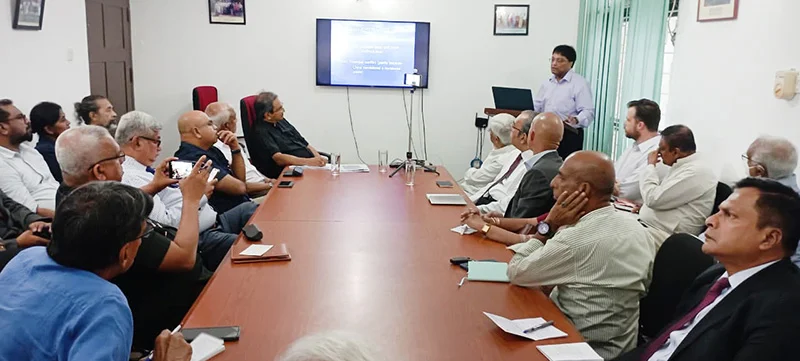
 The US-China rivalry could be said to make-up the ‘stuff and substance’ of world politics today but rarely does the international politics watcher and student of the global South in particular get the opportunity of having a balanced and comprehensive evaluation of this crucial relationship. But such a balanced assessment is vitally instrumental in making sense of current world power relations.
The US-China rivalry could be said to make-up the ‘stuff and substance’ of world politics today but rarely does the international politics watcher and student of the global South in particular get the opportunity of having a balanced and comprehensive evaluation of this crucial relationship. But such a balanced assessment is vitally instrumental in making sense of current world power relations.
Thanks to the Regional Centre for Strategic Studies (RCSS), Colombo the above window of opportunity was opened on December 8th for those sections of the public zealously pursuing an understanding of current issues in global politics. The knowledge came via a forum that was conducted at the RCSS titled, ‘The US-China Rivalry and Implications for the Indo-Pacific’, where Professor Neil DeVotta of the Wake Forest University of North Carolina in the US, featured as the speaker.
A widely representative audience was present at the forum, including senior public servants, the diplomatic corps, academics, heads of civil society organizations, senior armed forces personnel and the media. The event was ably managed by the Executive Director of the RCSS, retired ambassador Ravinatha Aryasinha. Following the main presentation a lively Q&A session followed, where many a point of interest was aired and discussed.
While there is no doubt that China is fast catching up with the US with regard to particularly military, economic, scientific and technological capability, Prof. DeVotta helped to balance this standard projection of ‘China’s steady rise’ by pointing to some vital facts about China, the omission of which would amount to the observer having a somewhat uninformed perception of global political realities.
The following are some of the facts about contemporary China that were highlighted by Prof. DeVotta:
* Money is steadily moving out of China and the latter’ s economy is slowing down. In fact the country is in a ‘ Middle Income Trap’. That is, it has reached middle income status but has failed to move to upper income status since then.
* People in marked numbers are moving out of China. It is perhaps little known that some Chinese are seeking to enter the US with a view to living there. The fact is that China’s population too is on the decline.
* Although the private sector is operative in China, there has been an increase in Parastatals; that is, commercial organizations run by the state are also very much in the fore. In fact private enterprises have begun to have ruling Communist Party cells in them.
* China is at its ‘peak power’ but this fact may compel it to act ‘aggressively’ in the international sphere. For instance, it may be compelled to invade Taiwan.
* A Hard Authoritarianism could be said to characterize central power in China today, whereas the expectation in some quarters is that it would shift to a Soft Authoritarian system, as is the case in Singapore.
* China’s influence in the West is greater than it has ever been.
The speaker was equally revelatory about the US today. Just a few of these observations are:
* The US is in a ‘Unipolar Moment’. That is, it is the world’s prime power. Such positions are usually not longstanding but in the case of the US this position has been enjoyed by it for quite a while.
* China is seen by the US as a ‘Revisionist Power’ as opposed to being a ‘Status Quo Power.’ That is China is for changing the world system slowly.
* The US in its latest national security strategy is paying little attention to Soft Power as opposed to Hard Power.
* In terms of this strategy the US would not allow any single country to dominate the Asia-Pacific region.
* The overall tone of this strategy is that the US should step back and allow regional powers to play a greater role in international politics.
* The strategy also holds that the US must improve economic ties with India, but there is very little mention of China in the plan.
Given these observations on the current international situation, a matter of the foremost importance for the economically weakest countries of the South is to figure out how best they could survive materially within it. Today there is no cohesive and vibrant collective organization that could work towards the best interests of the developing world and Dr. DeVotta was more or less correct when he said that the Non-alignment Movement (NAM) has declined.
However, this columnist is of the view that rather being a spent force, NAM was allowed to die out by the South. NAM as an idea could never become extinct as long as economic and material inequalities between North and South exist. Needless to say, this situation is remaining unchanged since the eighties when NAM allowed itself to be a non-entity so to speak in world affairs.
The majority of Southern countries did not do themselves any good by uncritically embracing the ‘market economy’ as a panacea for their ills. As has been proved, this growth paradigm only aggravated the South’s development ills, except for a few states within its fold.
Considering that the US would be preferring regional powers to play a more prominent role in the international economy and given the US’ preference to be a close ally of India, the weakest of the South need to look into the possibility of tying up closely with India and giving the latter a substantive role in advocating the South’s best interests in the councils of the world.
To enable this to happen the South needs to ‘get organized’ once again. The main differences between the past and the present with regard to Southern affairs is that in the past the South had outstanding leaders, such as Jawaharlal Nehru of India, who could doughtily stand up for it. As far as this columnist could ascertain, it is the lack of exceptional leaders that in the main led to the decline of NAM and other South-centred organizations.
Accordingly, an urgent task for the South is to enable the coming into being of exceptional leaders who could work untiringly towards the realization of its just needs, such as economic equity. Meanwhile, Southern countries would do well to, indeed, follow the principles of NAM and relate cordially with all the major powers so as to realizing their best interests.
Features
Sri Lanka and Global Climate Emergency: Lessons of Cyclone Ditwah
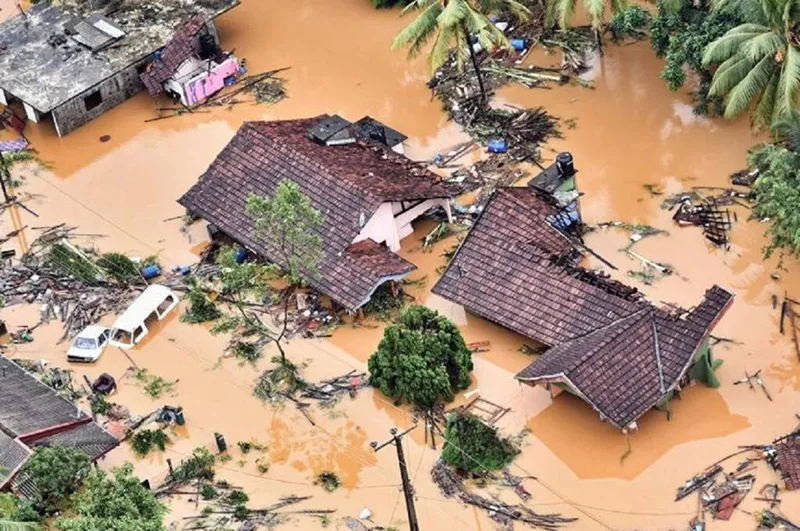
Tropical Cyclone Ditwah, which made landfall in Sri Lanka on 28 November 2025, is considered the country’s worst natural disaster since the deadly 2004 tsunami. It intensified the northeast monsoon, bringing torrential rainfall, massive flooding, and 215 severe landslides across seven districts. The cyclone left a trail of destruction, killing nearly 500 people, displacing over a million, destroying homes, roads, and railway lines, and disabling critical infrastructure including 4,000 transmission towers. Total economic losses are estimated at USD 6–7 billion—exceeding the country’s foreign reserves.
The Sri Lankan Armed Forces have led the relief efforts, aided by international partners including India and Pakistan. A Sri Lanka Air Force helicopter crashed in Wennappuwa, killing the pilot and injuring four others, while five Sri Lanka Navy personnel died in Chundikkulam in the north while widening waterways to mitigate flooding. The bravery and sacrifice of the Sri Lankan Armed Forces during this disaster—as in past disasters—continue to be held in high esteem by grateful Sri Lankans.
The Sri Lankan government, however, is facing intense criticism for its handling of Cyclone Ditwah, including failure to heed early warnings available since November 12, a slow and poorly coordinated response, and inadequate communication with the public. Systemic issues—underinvestment in disaster management, failure to activate protocols, bureaucratic neglect, and a lack of coordination among state institutions—are also blamed for avoidable deaths and destruction.
The causes of climate disasters such as Cyclone Ditwah go far beyond disaster preparedness. Faulty policymaking, mismanagement, and decades of unregulated economic development have eroded the island’s natural defenses. As climate scientist Dr. Thasun Amarasinghe notes:
“Sri Lankan wetlands—the nation’s most effective natural flood-control mechanism—have been bulldosed, filled, encroached upon, and sold. Many of these developments were approved despite warnings from environmental scientists, hydrologists, and even state institutions.”
Sri Lanka’s current vulnerabilities also stem from historical deforestation and plantation agriculture associated with colonial-era export development. Forest cover declined from 82% in 1881 to 70% in 1900, and to 54–50% by 1948, when British rule ended. It fell further to 44% in 1954 and to 16.5% by 2019.
Deforestation contributes an estimated 10–12% of global greenhouse gas emissions. Beyond removing a vital carbon sink, it damages water resources, increases runoff and erosion, and heightens flood and landslide risk. Soil-depleting monocrop agriculture further undermines traditional multi-crop systems that regenerate soil fertility, organic matter, and biodiversity.
In Sri Lanka’s Central Highlands, which were battered by Cyclone Ditwah, deforestation and unregulated construction had destabilised mountain slopes. Although high-risk zones prone to floods and landslides had long been identified, residents were not relocated, and construction and urbanisation continued unchecked.
Sri Lanka was the first country in Asia to adopt neoliberal economic policies. With the “Open Economy” reforms of 1977, a capitalist ideology equating human well-being with quantitative growth and material consumption became widespread. Development efforts were rushed, poorly supervised, and frequently approved without proper environmental assessment.
Privatisation and corporate deregulation weakened state oversight. The recent economic crisis and shrinking budgets further eroded environmental and social protections, including the maintenance of drainage networks, reservoirs, and early-warning systems. These forces have converged to make Sri Lanka a victim of a dual climate threat: gradual environmental collapse and sudden-onset disasters.
Sri Lanka: A Climate Victim
Sri Lanka’s carbon emissions remain relatively small but are rising. The impact of climate change on the island, however, is immense. Annual mean air temperature has increased significantly in recent decades (by 0.016 °C annually between 1961 and 1990). Sea-level rise has caused severe coastal erosion—0.30–0.35 meters per year—affecting nearly 55% of the shoreline. The 2004 tsunami demonstrated the extreme vulnerability of low-lying coastal plains to rising seas.
The Cyclone Ditwah catastrophe was neither wholly new nor surprising. In 2015, the Geneva-based Internal Displacement Monitoring Centre (IDMC) identified Sri Lanka as the South Asian country with the highest relative risk of disaster-related displacement: “For every million inhabitants, 15,000 are at risk of being displaced every year.”
IDMC also noted that in 2017 the country experienced seven disaster events—mainly floods and landslides—resulting in 135,000 new displacements and that Sri Lanka “is also at risk for slow-onset impacts such as soil degradation, saltwater intrusion, water scarcity, and crop failure”.
Sri Lanka ranked sixth among countries most affected by extreme weather events in 2018 (Germanwatch) and second in 2019 (Global Climate Risk Index). Given these warnings, Cyclone Ditwah should not have been a surprise. Scientists have repeatedly cautioned that warmer oceans fuel stronger cyclones and warmer air holds more moisture, leading to extreme rainfall. As the Ceylon Today editorial of December 1, 2025 also observed:
“…our monsoons are no longer predictable. Cyclones form faster, hit harder, and linger longer. Rainfall becomes erratic, intense, and destructive. This is not a coincidence; it is a pattern.”
Without urgent action, even more extreme weather events will threaten Sri Lanka’s habitability and physical survival.
A Global Crisis
Extreme weather events—droughts, wildfires, cyclones, and floods—are becoming the global norm. Up to 1.2 billion people could become “climate refugees” by 2050. Global warming is disrupting weather patterns, destabilising ecosystems, and posing severe risks to life on Earth. Indonesia and Thailand were struck by the rare and devastating Tropical Cyclone Senyar in late November 2025, occurring simultaneously with Cyclone Ditwah’s landfall in Sri Lanka.
More than 75% of global greenhouse gas emissions—and nearly 90% of carbon emissions—come from burning coal, oil, and gas, which supply about 80% of the world’s energy. Countries in the Global South, like Sri Lanka, which contribute least to greenhouse gas emissions, are among the most vulnerable to climate devastation. Yet wealthy nations and multilateral institutions, including the World Bank, continue to subsidise fossil fuel exploration and production. Global climate policymaking—including COP 30 in Belém, Brazil, in 2025—has been criticised as ineffectual and dominated by fossil fuel interests.
If the climate is not stabilised, long-term planetary forces beyond human control may be unleashed. Technology and markets are not inherently the problem; rather, the issue lies in the intentions guiding them. The techno-market worldview, which promotes the belief that well-being increases through limitless growth and consumption, has contributed to severe economic inequality and more frequent extreme weather events. The climate crisis, in turn, reflects a profound mismatch between the exponential expansion of a profit-driven global economy and the far slower evolution of human consciousness needed to uphold morality, compassion, generosity and wisdom.
Sri Lanka’s 2025–26 budget, adopted on November 14, 2025—just as Cyclone Ditwah loomed—promised subsidised land and electricity for companies establishing AI data centers in the country.
President Anura Kumara Dissanayake told Parliament: “Don’t come questioning us on why we are giving land this cheap; we have to make these sacrifices.”
Yet Sri Lanka is a highly water-stressed nation, and a growing body of international research shows that AI data centers consume massive amounts of water and electricity, contributing significantly to greenhouse gas emissions.
The failure of the narrow, competitive techno-market approach underscores the need for an ecological and collective framework capable of addressing the deeper roots of this existential crisis—both for Sri Lanka and the world.
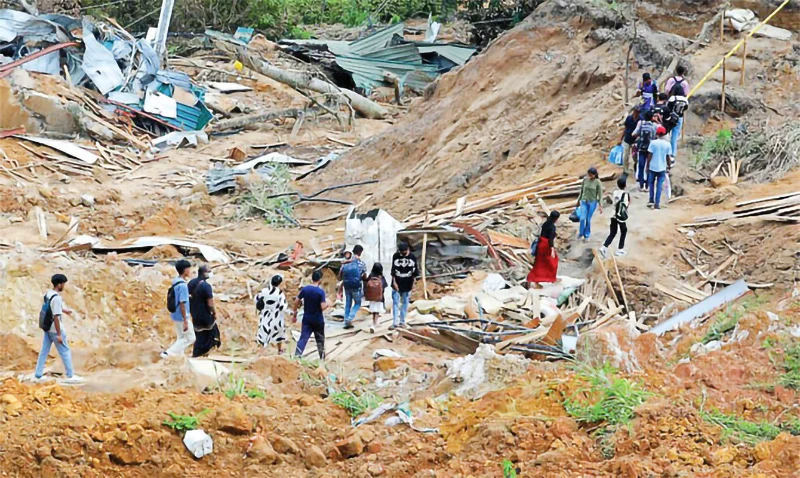
A landslide in Sri Lanka (AFP picture)
Ecological and Human Protection
Ecological consciousness demands
recognition that humanity is part of the Earth, not separate from it. Policies to address climate change must be grounded in this understanding, rather than in worldviews that prize infinite growth and technological dominance. Nature has primacy over human-created systems: the natural world does not depend on humanity, while humanity cannot survive without soil, water, air, sunlight, and the Earth’s essential life-support systems.
Although a climate victim today, Sri Lanka is also home to an ancient ecological civilization dating back to the arrival of the Buddhist monk Mahinda Thera in the 3rd century BCE. Upon meeting King Devanampiyatissa, who was out hunting in Mihintale, Mahinda Thera delivered one of the earliest recorded teachings on ecological interdependence and the duty of rulers to protect nature:
“O great King, the birds of the air and the beasts of the forest have as much right to live and move about in any part of this land as thou. The land belongs to the people and all living beings; thou art only its guardian.”
A stone inscription at Mihintale records that the king forbade the killing of animals and the destruction of trees. The Mihintale Wildlife Sanctuary is believed to be the world’s first.
Sri Lanka’s ancient dry-zone irrigation system—maintained over more than a millennium—stands as a marvel of sustainable development. Its network of interconnected reservoirs, canals, and sluices captured monsoon waters, irrigated fields, controlled floods, and even served as a defensive barrier. Floods occurred, but historical records show no disasters comparable in scale, severity, or frequency to those of today. Ancient rulers, including the legendary reservoir-builder King Parākramabāhu, and generations of rice farmers managed their environment with remarkable discipline and ecological wisdom.
The primacy of nature became especially evident when widespread power outages and the collapse of communication networks during Cyclone Ditwah forced people to rely on one another for survival. The disaster ignited spontaneous acts of compassion and solidarity across all communities—men and women, rich and poor, Buddhists, Christians, Muslims, and Hindus. Local and international efforts mobilized to rescue, shelter, feed, and emotionally support those affected. These actions demonstrated a profound human instinct for care and cooperation, often filling vacuums left by formal emergency systems.
Yet spontaneous solidarity alone is insufficient. Sri Lanka urgently needs policies on sustainable development, environmental protection, and climate resilience. These include strict, science-based regulation of construction; protection of forests and wetlands; proper maintenance of reservoirs; and climate-resilient infrastructure. Schools should teach environmental literacy that builds unity and solidarity, rather than controversial and divisive curriculum changes like the planned removal of history and introduction of contested modules on gender and sexuality.
If the IMF and international creditors—especially BlackRock, Sri Lanka’s largest sovereign bondholder, valued at USD 13 trillion—are genuinely concerned about the country’s suffering, could they not cancel at least some of Sri Lanka’s sovereign debt and support its rebuilding efforts? Addressing the climate emergency and the broader existential crisis facing Sri Lanka and the world ultimately requires an evolution in human consciousness guided by morality, compassion, generosity and wisdom. (Courtesy: IPS NEWS)
Dr Asoka Bandarage is the author of Colonialism in Sri Lanka: The Political Economy of the Kandyan Highlands, 1833-1886 (Mouton) Women, Population and Global Crisis: A Politico-Economic Analysis (Zed Books), The Separatist Conflict in Sri Lanka: Terrorism, Ethnicity, Political Economy, ( Routledge), Sustainability and Well-Being: The Middle Path to Environment, Society and the Economy (Palgrave MacMillan) Crisis in Sri Lanka and the World: Colonial and Neoliberal Origins, Ecological and Collective Alternatives (De Gruyter) and numerous other publications. She serves on the Advisory Boards of the Interfaith Moral Action on Climate and Critical Asian Studies.
Features
Cliff and Hank recreate golden era of ‘The Young Ones’

 Cliff Richard and Hank Marvin’s reunion concert at the Riverside Theatre in Perth, Australia, on 01 November, 2025, was a night to remember.
Cliff Richard and Hank Marvin’s reunion concert at the Riverside Theatre in Perth, Australia, on 01 November, 2025, was a night to remember.
The duo, who first performed together in the 1950s as part of The Shadows, brought the house down with their classic hits and effortless chemistry.
The concert, part of Cliff’s ‘Can’t Stop Me Now’ tour, featured iconic songs like ‘Summer Holiday’, ‘The Young Ones’, ‘Bachelor Boy’, ‘Living Doll’ and a powerful rendition of ‘Mistletoe and Wine.’
Cliff, 85, and Hank, with his signature red Fender Stratocaster, proved that their music and friendship are timeless.
According to reports, the moment the lights dimmed and the first chords of ‘Move It’ rang out, the crowd knew they were in for something extraordinary.
Backed by a full band, and surrounded by dazzling visuals, Cliff strode onto the stage in immaculate form – energetic and confident – and when Hank Marvin joined him mid-set, guitar in hand, the audience erupted in applause that shook the hall.
Together they launched into ‘The Young Ones’, their timeless 1961 hit which brought the crowd to its feet, with many in attendance moved to tears.
The audience was treated to a journey through time, with vintage film clips and state-of-the-art visuals adding to the nostalgic atmosphere.
Highlights of the evening included Cliff’s powerful vocals, Hank’s distinctive guitar riffs, and their playful banter on stage.
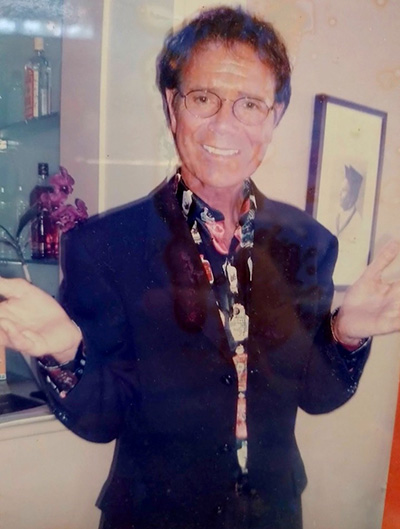
Cliff posing for The Island photographer … February,
2007
Cliff paused between songs to reflect on their shared journey saying:
“It’s been a lifetime of songs, memories, and friendship. Hank and I started this adventure when we were just boys — and look at us now, still up here making noise!”
As the final chords of ‘Congratulations’ filled the theatre, the crowd rose for a thunderous standing ovation that lasted several minutes.
Cliff waved, Hank gave a humble bow, and, together, they left the stage, arm-in-arm, to the refrain of “We’re the young ones — and we always will be.”
Reviews of the show were glowing, with fans and critics alike praising the duo’s energy, camaraderie, and enduring talent.
Overall, the Cliff Richard and Hank Marvin reunion concert was a truly special experience, celebrating the music and friendship that has captivated audiences for decades.
When Cliff Richard visited Sri Lanka, in February, 2007, I was invited to meet him, in his suite, at a hotel, in Colombo, and I presented him with my music page, which carried his story, and he was impressed.
In return, he personally autographed a souvenir for me … that was Cliff Richard, a truly wonderful human being.
-

 News3 days ago
News3 days agoOver 35,000 drug offenders nabbed in 36 days
-

 Business5 days ago
Business5 days agoLOLC Finance Factoring powers business growth
-

 Features1 day ago
Features1 day agoFinally, Mahinda Yapa sets the record straight
-

 News2 days ago
News2 days agoCyclone Ditwah leaves Sri Lanka’s biodiversity in ruins: Top scientist warns of unseen ecological disaster
-

 News5 days ago
News5 days agoCPC delegation meets JVP for talks on disaster response
-

 News5 days ago
News5 days agoA 6th Year Accolade: The Eternal Opulence of My Fair Lady
-

 News3 days ago
News3 days agoRising water level in Malwathu Oya triggers alert in Thanthirimale
-
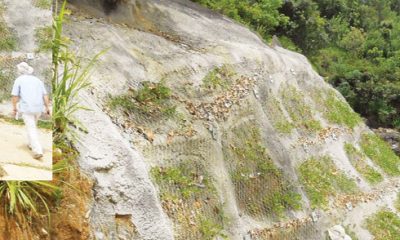
 Features4 days ago
Features4 days agoThe Catastrophic Impact of Tropical Cyclone Ditwah on Sri Lanka:













